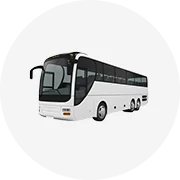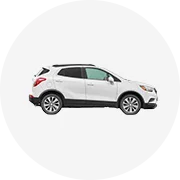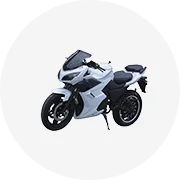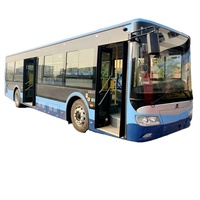
Recommend Zhongtong Used Bus LCK6131A White Color Sleeper Coaches 38 Seater Long Travelling Bus Price for Sale

















Choosing the right color for your transport business goes beyond personal preference; it taps into the deep psychological connections we have with hues. The color of your fleet is a silent ambassador for your brand, conveying messages of reliability, eco-friendliness, or vibrant energy without saying a word. In the competitive landscape of transportation, the strategic use of color can not only distinguish your buses from the crowd but also influence how your brand is perceived and remembered. This article delves into the psychology of colors, offering insights into how the right choice can enhance your brand's message and impact the passenger experience.

Colors serve as crucial visual cues in branding, particularly within the transportation industry. The choice of color for a transport logo can convey a multitude of information to the audience, subtly influencing their perception of the brand. For instance, certain colors can suggest that a transport brand is eco-friendly, while others may imply reliability and trustworthiness. The shade of the color chosen is equally important, as different hues can evoke varying emotional responses. A deep blue might be associated with dependability, whereas a lighter blue could suggest a more relaxed and approachable brand personality.
In the context of transport logos, orange can symbolize speed and efficiency, green can indicate an eco-conscious approach, and brown may represent strength and reliability. Red, often associated with passion and energy, can make a bold statement for a brand that wants to be perceived as dynamic and confident. On the other hand, yellow often brings forth feelings of optimism and confidence, which can be beneficial for transport companies aiming to project a positive and assured image.
The psychological impact of these colors on branding and transport is significant, as they can enhance and complement the brand message. When selecting a color for a transport business, it's essential to consider these psychological implications to ensure the color aligns with the brand's values and the message it intends to communicate. The right color choice can make a transport logo stand out and resonate with the target audience, ultimately contributing to the brand's identity and recognition.
Color psychology is a significant aspect of branding and marketing, as it influences human behavior and emotional responses. Certain colors can evoke physical reactions; for instance, red may increase blood pressure, while blue might have a calming effect. This understanding is crucial for businesses, as the choice of color in branding can set a mood, energize or calm an audience, and ultimately affect consumer behavior. In the context of a transport business, selecting the right bus color is not just a matter of aesthetics but also of psychological impact. The hues chosen for a fleet can convey a brand's identity and values, and influence passenger perceptions. Therefore, it's essential to consider the psychological implications of color when deciding on the palette for your buses, ensuring that it aligns with the desired brand message and customer experience.

The strategic selection of colors for fleet graphics is not just about aesthetics; it's a powerful psychological tool that can influence consumer behavior and brand perception. Red, for instance, is known to stimulate and excite, making it a vibrant choice for attracting attention and encouraging impulse purchases. On the other hand, blue conveys stability and reliability, often favored in corporate identities but less appetizing in food-related industries.
Yellow, with its bright and eye-catching hue, can invoke feelings of happiness and confidence, yet it's also associated with frustration if overused. Green's association with nature and health can signal premium quality, which may or may not resonate positively with all demographics. Violet, a color historically linked to wealth and royalty, carries connotations of luxury and exclusivity.
When choosing the right hue for your fleet, it's crucial to consider these psychological impacts, as well as the demographic and cultural implications of color perception. The goal is to select a palette that not only stands out but also aligns with the brand message you wish to convey to your audience. Thoughtful use of color can be a decisive factor in the effectiveness of your fleet as a mobile billboard, enhancing brand recognition and influencing consumer behavior on the road.
The use of vibrant colors in transportation can have a profound impact, serving not just aesthetic purposes but also as a cultural narrative. Thoughtful use of color and cultural motifs can turn a vehicle into a statement, making it a focal point in the urban landscape.
The color of a bus can significantly influence the passenger experience. For instance, colors like blue and green are often associated with serenity and tranquility, potentially creating a calming environment for passengers. Blue, known for its ability to lower pulse rate and body temperature, may contribute to a cooler and more relaxed journey. Green, reminiscent of nature, can enhance the feeling of freshness and calm, possibly reducing stress during travel.
Conversely, warm colors such as red and orange might evoke feelings of excitement and warmth. Red, which can increase energy levels and metabolism, might be used strategically to invigorate short-distance travelers or in areas where alertness is paramount. Orange, associated with creativity and enthusiasm, could be chosen to stimulate a lively atmosphere within the bus.
Yellow, the most attention-grabbing color, may increase mental activity and muscle energy, which could be beneficial in keeping passengers engaged during their commute. However, it's important to consider that an overuse of bright yellow might be overwhelming for some individuals.
The psychological effects of color are an essential consideration for transport businesses when selecting their fleet's palette. By understanding the impact of hues on mood and physical well-being, companies can enhance the overall travel experience for their passengers.

While personal style is a significant factor in choosing a vehicle's color, practicality is equally crucial, especially for buses. Practical considerations include visibility on the road, which can influence safety. Lighter colors tend to stay cleaner-looking longer and can reflect sunlight, potentially reducing cooling costs in warmer climates. On the other hand, darker colors might require more frequent cleaning but can give a sleek appearance. It's essential to weigh these practical elements alongside aesthetic preferences to select a color that is both appealing and functional for a fleet of buses.
Maintaining the paint on buses is crucial, not just for aesthetic appeal but also for the vehicle's longevity. Regular and proper washing can significantly extend the life of the paint, while incorrect methods can cause damage. It's important to avoid harsh chemicals like degreasers and certain soaps that can strip away the paint's shine.
Choosing the right cleaning products is essential. Some specialized cleaners, although more expensive, are formulated to remove dirt without harming the paint. Additionally, using the correct washing techniques and equipment, such as touchless systems, can prevent the wear that brush-type wash systems may cause.
Occasional waxing can also preserve the paint's gloss and offer protection from corrosive substances like road salt. When paint does suffer damage, prompt attention to scratches and rust spots is necessary. There are treatments available that can restore the color of faded paint and seal it to prevent further damage.
The timing for repainting depends on various factors, including geographical location and maintenance practices. Addressing rust spots early is critical, and refurbishing work is often scheduled during periods like summer when buses are less in use. The choice of paint and the process of application should be carefully considered to ensure durability and adherence to safety standards.
Environmental considerations are key when selecting the appropriate bus color. Factors such as the local climate, the natural and urban landscape, and the need for visibility in different weather conditions play a significant role in the decision-making process. The right color can enhance a bus's visibility to other road users, contributing to safety, while also reflecting the brand's identity and values.
Alibaba.com stands as a pivotal resource for transport businesses looking to enhance their fleet with the right bus parts. The platform offers a diverse array of bus components, including essential parts like air dryers, clutch pressure plates, chassis, and engine parts, which are crucial for maintaining the performance and safety of buses. For businesses aiming to provide a comfortable passenger experience, luxury accessories such as bus seats and sunshades are also available. The variety extends to electrical components like LED tail lamps and headlamps, ensuring that buses are well-equipped for visibility and safety during travel.
The site's comprehensive collection caters to a wide range of bus models, ensuring compatibility and ease of replacement. This includes parts tailored to regional preferences, enhancing the serviceability of buses across different markets. Moreover, the platform's inventory includes both manual and electric options for bus stop boards, catering to different operational needs.
Transport businesses can benefit from the convenience of finding all necessary bus parts in one place, which can streamline procurement processes and reduce downtime. The availability of a wide range of parts on Alibaba.com allows for the selection of components that not only meet functional requirements but also align with the aesthetic aspects of bus coloring and branding, contributing to a cohesive and appealing fleet appearance.
In conclusion, the color of your transport fleet is a powerful tool in branding, influencing both the perception of your company and the experience of your passengers. From the trust-evoking blues to the energetic reds, each hue carries its own psychological weight and practical implications. Cultural narratives and environmental factors also play a pivotal role in selecting a palette that resonates with your audience and stands the test of time. Maintenance considerations, such as durability and cleaning requirements, must be balanced with aesthetic appeal. Leveraging platforms like Alibaba.com can further align your transport business's functional needs with its branding goals, ensuring that every aspect of your fleet, from parts to paint, contributes to a cohesive and appealing presence on the road. The right color choice is not just about looking good—it's about creating a moving representation of your brand's values and vision.